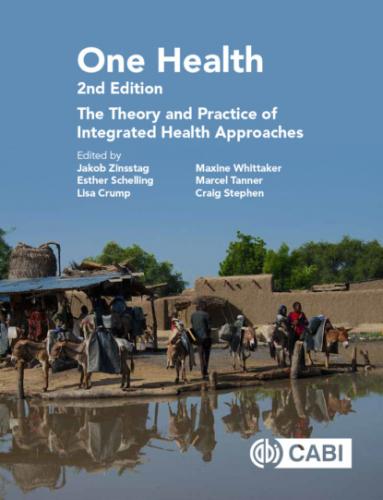Craig Stephen, Western College of Veterinary Medicine, University of Saskatchewan, Saskatoon, Canada; The School of Population and Public Health, University of British Columbia, Vancouver, British Columbia, Canada. E-mail: [email protected]
Arlette C. Szelecsenyi, Division of Infectious Diseases & Hospital Epidemiology, University Hospital Basel, Basel, Switzerland. E-mail: [email protected]
Marcel Tanner, Swiss Tropical and Public Health Institute, Basel, Switzerland; University of Basel, Basel, Switzerland. E-mail: [email protected]
Tenzin Tenzin, National Centre for Animal Health, Department of Livestock, Thimphu, Bhutan. E-mail: [email protected]
Jimmy Tickel, Institute for Infectious Animal Diseases, Texas A&M University, College Station, Texas, USA. E-mail: [email protected]
Karin Tschanz Cooke, Director of Training in Palliative and Spiritual Care, Reformed Church Aargau, Aargau, Switzerland; Director of Systemic Pastoral Care, University of Bern, Bern, Switzerland; Chaplain, Hirslanden Clinic, Aarau, Switzerland. E-mail: [email protected]
Rea Tschopp, Swiss Tropical and Public Health Institute, Basel, Switzerland; University of Basel, Basel, Switzerland; Armauer Hansen Research Institute, Addis Ababa, Ethiopia. E-mail: [email protected]
Dennis C. Turner, Institute for applied Ethology and Animal Psychology, Horgen/Zurich, Switzerland. E-mail: [email protected]
Hoang Van Minh, Centre for Public Health and Ecosystem Research, Hanoi University of Public Health, Hanoi, Vietnam. E-mail: [email protected]
Alain Vandermissen, European Union, European External Action Service, Brussels, Belgium. E-mail: [email protected]
Pascale Vonaesch, Swiss Tropical and Public Health Institute, Basel, Switzerland; University of Basel, Basel, Switzerland. E-mail: [email protected]
Tu Vu-Van, Centre for Public Health and Ecosystem Research, Hanoi University of Public Health, Hanoi, Vietnam. E-mail: [email protected]
Daniel P. Walsh, United States Geological Survey, National Wildlife Health Center, Madison, Wisconsin, USA. E-mail: [email protected]
David Waltner-Toews, Ontario Veterinary College, University of Guelph, Guelph, Canada (Emeritus). E-mail: [email protected]
Sylvia Wanzala, Department of Veterinary Population Medicine, College of Veterinary Medicine, University of Minnesota, St Paul, Minnesota, USA. E-mail: [email protected]
Susan C. Welburn, Infection Medicine, Biomedical Sciences, Edinburgh Medical School, The University of Edinburgh, Edinburgh, UK; Zhejiang University-University of Edinburgh Institute, Zhejiang University School of Medicine, International Campus, Zhejiang University, Haining, China. E-mail: [email protected]
Lenke Wettlaufer, Berlin Appellate Court, Berlin, Germany. E-mail: [email protected]
C. LeAnn White, United States Geological Survey, National Wildlife Health Center, Madison, Wisconsin, USA. E-mail: [email protected]
Maxine Whittaker, James Cook University, Townsville, Australia. E-mail: [email protected]
Andreas F. Widmer, Division of Infectious Diseases & Hospital Epidemiology, University Hospital Basel, Basel, Switzerland. E-mail: [email protected]
Abigail Woods, College of Arts, University of Lincoln, Lincoln, UK. E-mail: [email protected]
Hind Yahyaoui, Department of Infectious Diseases, College of Veterinary Medicine, University of Georgia, Athens, Georgia, USA. E-mail: [email protected]
Jakob Zinsstag, Swiss Tropical and Public Health Institute, Basel, Switzerland; University of Basel, Basel, Switzerland. E-mail: [email protected]
Christian Zurbrügg, Swiss Federal Institute of Aquatic Science and Technology, Department of Water and Sanitation in Developing Countries, Dübendorf, Switzerland. E-mail: [email protected]
Editors’ Preface to the Second Edition
Five years after the publication of the first edition in 2015, we have the pleasure and possibility to produce a second edition of One Health: the Theory and Practice of Integrated Health Approaches. The present updated and largely revised version is motivated by the numerous, worldwide and most relevant activities in research and public health action aimed at implementing and carefully validating One Health approaches and also to make One Health a global public health reality. We are truly overwhelmed to realize how One Health thinking and actions have spread in near-epidemic dimensions. It is gratifying to see how the initial focus on zoonotic diseases expanded rapidly to encompass social and cultural dimensions, including transdisciplinary participatory approaches co-producing transformational knowledge between academic and non-academic actors like communities, authorities and the private sector, as a central element for negotiation of the required multilevel cooperation under the One Health paradigm.
One Health embraces the environmental and ecological dimension of health, fuelled by climate change, pollution, waste management crises, the dramatic decline of biodiversity and extinction of wildlife species and plants and therefore makes significant contributions to the global attempts of reaching the Sustainable Development Goals (SDGs). Non-communicable diseases, gradually and rapidly dominating the worldwide burden of diseases, extend the scope of One Health by their linkages to nutrition, food safety and security as well as mental and spiritual health, animal-assisted interventions and the human–animal bond.
Increasing antimicrobial resistance (AMR) globally raises serious health and economic concerns. The main drivers and determinants of the spread and subsequent colonization of resistant bacterial strains between humans, animals and the environment are still mostly unknown. AMR is therefore not only a quintessential One Health issue, but One Health is an essential prerequisite for a systemic understanding of AMR acquisition and spread and for identifying, developing and validating effective control strategies.
The current most illustrative example for the need for integrated approaches to health is the spread of the new coronavirus (COVID-19). It demonstrates the
